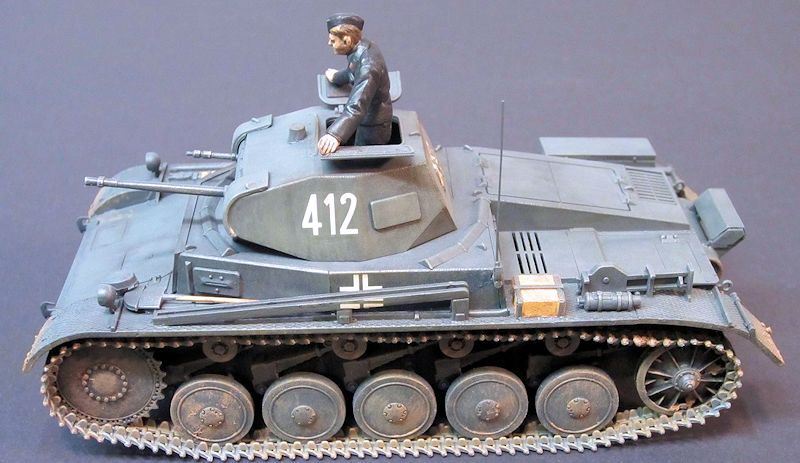
Tamiya 1/48 Panzer II
| KIT #: | 32570 |
| PRICE: | $31.00 SRP |
| DECALS: | Three options |
| REVIEWER: | Jonathan Prestidge |
| NOTES: |

| HISTORY |
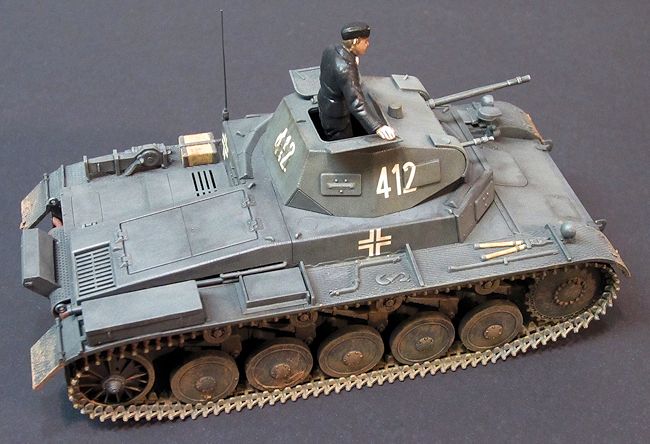 produce the
Panzer II, a compact 4.8cm long, 2.2m wide design with a three man crew. The 8.9
ton tank featured a 2cm Kwk 30 L/55 cannon and 7.92mm machine gun in the turret,
15mm armor protection for turret and hull front, leaf spring suspension, and a
140hp Maybach HL 62 TRM engine matched with a ZF SSG46 transmission, which gave
in a 40km/h top speed. The Ausf. A was produced from 1937, followed by the Ausf.
B and C, which were difficult to distinguish from each other visually. About
1,100 Panzer II tanks were produced by April 1940, and due to delays with the
Panzer III, they were immediately issued as the Panzer divisions’ main tank for
the invasion of Poland in September 1939. Based on lessons learned on the
battlefields of Poland and, in May 1940, France, improvements such as extra
armor and a turret cupola were added, and the Panzer II went on to serve in
North Africa and Russia in frontline liaison and reconnaissance duties until the
end of 1943. Afterwards, they were used to police occupied territories and the
chassis was also adapted for use as the basis for various self-propelled gun
designs.”
produce the
Panzer II, a compact 4.8cm long, 2.2m wide design with a three man crew. The 8.9
ton tank featured a 2cm Kwk 30 L/55 cannon and 7.92mm machine gun in the turret,
15mm armor protection for turret and hull front, leaf spring suspension, and a
140hp Maybach HL 62 TRM engine matched with a ZF SSG46 transmission, which gave
in a 40km/h top speed. The Ausf. A was produced from 1937, followed by the Ausf.
B and C, which were difficult to distinguish from each other visually. About
1,100 Panzer II tanks were produced by April 1940, and due to delays with the
Panzer III, they were immediately issued as the Panzer divisions’ main tank for
the invasion of Poland in September 1939. Based on lessons learned on the
battlefields of Poland and, in May 1940, France, improvements such as extra
armor and a turret cupola were added, and the Panzer II went on to serve in
North Africa and Russia in frontline liaison and reconnaissance duties until the
end of 1943. Afterwards, they were used to police occupied territories and the
chassis was also adapted for use as the basis for various self-propelled gun
designs.”
| THE KIT |
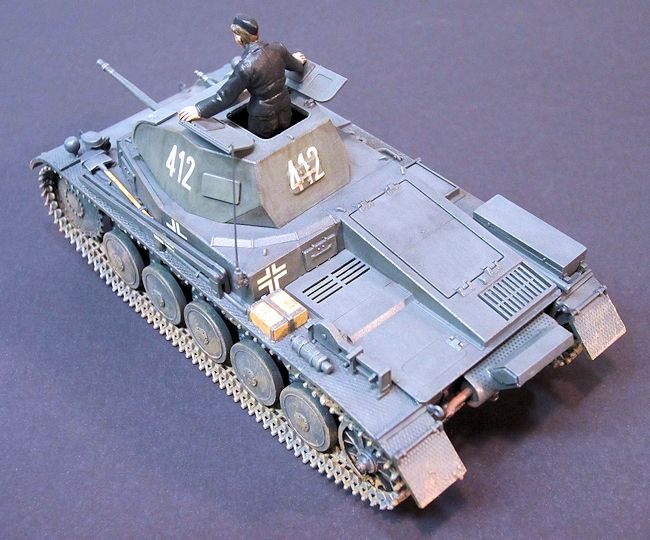 Tamiya’s
1/48th Panzerkampfwagen II is kit No. 70 in their Military Miniatures
series. The instructions are well printed and easy to follow. The engineering of
the Panzer II is superb, resulting in beautiful detail without difficult
construction or an excessive parts count. The kit is crisply molded in dark gray
plastic and there is almost no flash on the kit parts. Compared with other kits
in Tamiya’s 1/48th scale armor line, this one is delicate. There are
many petite parts that are easily lost or broken. One commander figure is
included. The molding of the figure is very good. The kit decals are thin, in
register, and provide markings for three Panzer IIs - all wearing Panzer Gray
and serving during the battle of France. There are metal chassis weights and
nice link and length tracks with the longer portions pre-formed, minimizing
assembly time.
Tamiya’s
1/48th Panzerkampfwagen II is kit No. 70 in their Military Miniatures
series. The instructions are well printed and easy to follow. The engineering of
the Panzer II is superb, resulting in beautiful detail without difficult
construction or an excessive parts count. The kit is crisply molded in dark gray
plastic and there is almost no flash on the kit parts. Compared with other kits
in Tamiya’s 1/48th scale armor line, this one is delicate. There are
many petite parts that are easily lost or broken. One commander figure is
included. The molding of the figure is very good. The kit decals are thin, in
register, and provide markings for three Panzer IIs - all wearing Panzer Gray
and serving during the battle of France. There are metal chassis weights and
nice link and length tracks with the longer portions pre-formed, minimizing
assembly time.
| CONSTRUCTION |
I started by
carefully reviewing the kit instructions. Using them as a loose reference, I
built the kit in three major sub-assemblies: the chassis, the upper hull, and
the turret. I also left the tracks off until after painting for easier
weathering. The excellent fit of the parts, minimal cleanup and excellent
engineering really made for a rewarding and painless build. However, many small
parts required extra care during clean up and assembly. I broke several of the
track links while cutting them from the sprue and had to repair them prior to
assembly. After about five hours of building, I had the three main components
(chassis, upper hull and turret) ready for paint.
| COLORS & MARKINGS |
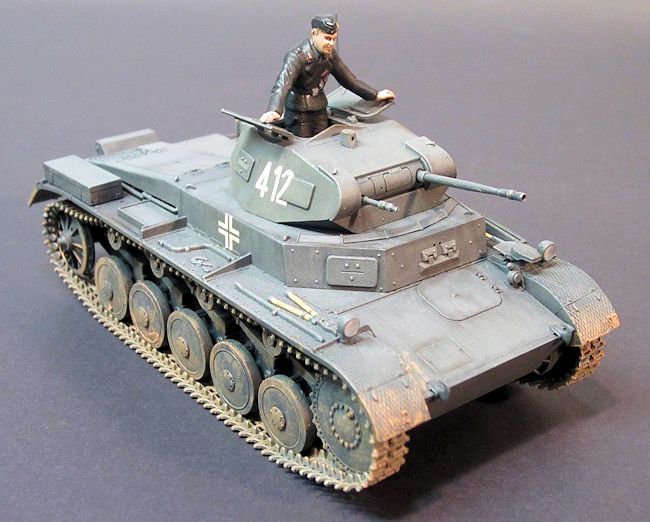
I added the commander figure at
this time. I then air-brushed Poly Scale Flat Clear mixed with a few drops of
Hazel Tan over the entire tank. I used pastels to further dirty the Panzer II.
Finally, I added thickened brown paint scraped from the lids of my paint
containers with a toothpick to depict mud on the tracks & fenders. I added a
stretched sprue antenna and final detailing was then completed.
| CONCLUSIONS |
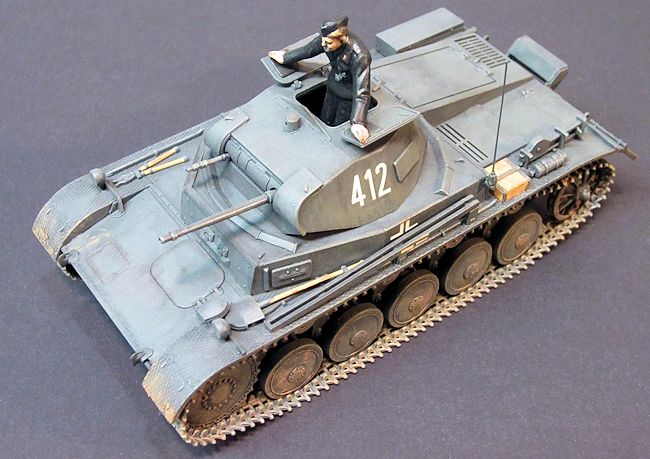 From start
to finish, Tamiya’s Panzer II took me less than 15 hours over the course of a
week! Construction of the Panzer II was enjoyable and relaxing with no
insurmountable trouble spots. Tamiya’s smart engineering, terrific fit,
beautiful moldings and nice decals, resulted in a great looking finished
product. Weathering a monotone paint scheme was a fun challenge. I really
enjoyed Tamiya’s 1/48th scale Panzer II. The finished tank is small and due to
the delicate nature of this kit I would recommend it to modelers with some
experience. Highly recommended!
From start
to finish, Tamiya’s Panzer II took me less than 15 hours over the course of a
week! Construction of the Panzer II was enjoyable and relaxing with no
insurmountable trouble spots. Tamiya’s smart engineering, terrific fit,
beautiful moldings and nice decals, resulted in a great looking finished
product. Weathering a monotone paint scheme was a fun challenge. I really
enjoyed Tamiya’s 1/48th scale Panzer II. The finished tank is small and due to
the delicate nature of this kit I would recommend it to modelers with some
experience. Highly recommended!
April 2014 If you would like your product reviewed fairly and fairly quickly, please
contact
the editor or see other details in the
Note to
Contributors.